Timing is something that freaks people out when they do it for the first time. It’s like the first time for some other things, both scary and exciting at the same time. I know I was freaked out about it when I started work on my Subaru. But I found it quite strait forward once I got into it and hope my experience can help you out. It’s an important thing to learn, as they say, timing is everything.
When I read the Haynes repair manual, it made me think that setting the timing is super complicated and that I suck and won’t be good enough to do it. Not true, I did it and my car is still running great. I know you are good enough to set the timing on your Subie too! Thus, this is a pretty detailed post as I tried not to leave anything out. So, get cozy. Also, if you have any questions or want to make a comment. Please leave one at the bottom.
For those who aren’t familiar. The job of the timing belt is to position the valves correctly in relation to the pistons for intake of fuel and exhaust. So, when a timing belt is set in the incorrect position (or wears out), valves can be smashed by the pistons and severe engine damage occurs.
With most cars, timing is set to top dead center on number 1 piston. But on a Subaru with their funny horizontal boxer engine, it is set at mid-stroke. For those not familiar, I will explain what that means later. This DIY post will explain the most minimal way to access the timing belt for doing a timing belt change. If you are already taking the engine apart for something like a head gasket job, you can ignore the first part of this post.
These are the basic tools required for this job:
1/2″ and 3/8″ ratchets, 10mm, 12mm, 14mm, 17mm and 22mm sockets, some long extensions, 14mm wrench, possibly some other wrenches, a whole socket and wrench set would be ideal. Just make sure you have a 22mm socket (my set doesn’t have one). You’ll also need a little pin (as pictured) or a small drill bit to hold the tensioner compressed, a breaker bar (possibly with an extending pipe for extra leverage, a strap wrench (or chain wrench would be better), a large phillips screw driver, flat head screw driver and some long bent needle nose come in pretty handy too.
You will also probably want some power tools. The harmonic balancer is torqued to 130 ft.lb. and breaking that bolt loose is the biggest pain in the ass of this job.
A cordless impact wrench like the one in the middle is a very useful tool I would highly recommend for anyone doing much work on cars. I just got that wrench and wish I got it sooner. It won’t, however, bust off the harmonic balancer. That big bad Chicago Pneumatics air wrench will, but won’t fit in the space available in the engine bay. A butterfly wrench will, if you have one. An air ratchet is handy for taking off the tensioner for the a/c belt if you don’t have cordless impact wrench.
There are a few other tools that you might want to have, we’ll cover that when we get there.
This blog is based on my experience working on an 2004 Legacy Outback, I know this procedure would be exactly the same for many other years of Legacys, and probably the same or very similar for many years of Foresters and Imprezas with a EJ25 SOHC.
Let’s start taking your car apart!
I would recommend jacking up the front of the car and supporting it on jack stands.
Disconnect the negative terminal from the battery.
Remove the plastic splash shield underneath, 5 x 12mm bolts underneath and 2 x 10mm screws in the wheel wells.
For consistencies sake, I will refer to the left and right side of the car as if you were in the car, like most mechanics do, though I’m not a mechanic.
Get a bucket or drain pan under the cock at the bottom right of the radiator. Get your big phillips screw driver out and loosen that cock up (things are starting to get exciting already). Careful not to strip it, it is only plastic. Pull the cock out and drain your coolant.
While the coolant is draining, remove the ram air intake. A couple of 10mm bolts in the radiator support bar. I have a video on my Youtube channel which shows this in detail.
https://www.youtube.com/watch?v=zwy0SlmHTzg
Loosen the hose clamps on the radiator hoses and remove those too. You may have to wiggle and pry them a bit to get them loose.
Get under the car and unplug the two hose fans, push the tab up in the clips with a flat head screwdriver to loosen them.
If you have an automatic transmission, there is probably a transmission cooler down there too, that will need to have the hoses disconnected. My car’s a manual, so, not totally sure.
Double check that there isn’t anything connected to the radiator, then remove the two 12mm bolts holding the radiator to the support bracket. You can then lift the whole radiator out with the fans and bottle still attached. The bottom of the radiator is in a couple of rubber seats and might take a bit of pursuation to free from the car.
With that out of the way, you will have a lot more room to work.
Remove the drive belt covers. You remove a 10mm nut and bolt, then just loosen the bolt holding the alternator onto the a/c compressor. Leave it loose so the alternator can ‘hang loose dude’.
Your engine will look something like this now. Except your power steering lines should still be attached. Label your drive belts with a paint marker, as illustrated, if you plan to reuse them.
Note: you can click on any of the pictures for a larger view.
Crank the tensioner bolt (14mm) beside the alternator so that the alternator drops down enough to remove the front drive belt.
Then loosen the locknut under the tensioner bolt for the a/c belt, loosen the bolt on the pulley, so it can slide. Then put a 14mm wrench on the bolt at the bottom of tensioner bolt and crank the bolt clockwise to loosen (it is reverse threaded).
Remove the belt once it is loose, then remove the two 14mm bolts from the block and the bracket itself.
Now you have easy access to the timing belt cover, hurray!
Except you still need to remove the harmonic balancer, that big effin pulley in the middle, boo!
Put your chain wrench with an old piece of belt to protect the pulley (or strap wrench) around the harmonic balancer.
Assuming you don’t have an impact wrench that will fit in there. Get your breaker bar out with the 22mm socket on it and start heaving. A ratchet with a hammer can work too. Either way, it is going to be a lot of work and you will be ready to give up at one point. But hang in there, it will eventually come loose.
Just be careful not to go too far over and break off the end of your coolant supply line. Because then you will curse and swear and have to weld it back on or replace the line.
After you get the harmonic balancer off and take a little break. Remove all of the hundred little 10mm bolts holding the timing belt cover off.
Then you will have a view something like this:
Yes, success!
Now, here is the fun part. You need to set your timing! Basically, put your car in neutral (if it isn’t already) and get these two index marks to line up like this:
If you car is like mine, there might be some dirt on the upper mark. Clean it off to locate it correctly. It isn’t quite strait up.
There are a couple of ways you can do this:
Put the harmonic balancer back on the crank sprocket with the 22mm bolt and crank the engine over (make sure it’s in neutral) with a ratchet.
Or, use two 17mm wrenches and crank over the two cam shaft sprockets simultaneously. A lot of mechanics wouldn’t recommend this. But it will work fine if you are careful and some people find it easier.
The camshaft sprockets should be inline with the index marks on the camshaft cover and marked on the block.
These two should actually be over to the right a little bit. The first photo of the whole engine has them in the right spot. But don’t worry too much about having these perfect. Just make sure the crank shaft sprocket is in the exact right spot.
It is a good idea to mark the relationship between the index marks with your belt (cam sprockets too) and the direction of the belt. Even if you don’t plan to reuse your old belt. Because you can use it as a reference to make sure that everything is lined up correctly before putting the new belt on.
Also, this crank sprocket isn’t lined up correctly. Again why you need to clean that dirt off of the index mark above.
To remove the timing belt:
First remove the little metal cover over the crankshaft sprocket (if applicable).
Then, one might think to first take the tensioner (blue pulley) off first. But DON’T DO THAT! That would throw too much tension out of the belt at once and throw off your timing, you so carefully set.
Instead, first remove the orange pulley (bottom left of photo), then the cogged pulley (or sprocket) beside the water pump, they are often coloured green, then remove the tensioner and the belt. You can leave the black pulley on unless you are replacing it.
Replacing the Timing Belt
In case you did pull the tensioner pulley off first and threw your timing off during removal. Or if you had the engine apart for another repair and need to move the crank over or valves, here are a few things to note so you don’t accidentally smash any valves.
If your crankshaft is at the index mark (or close to), you can freely move the cams around without coming anywhere near the pistons.
Or if you need to move the crank around and you think that some of the valves might be out, just turn the camshafts around until they feel loose, that means the valves are closed. But only do this if the crank is close to the index mark.
This will hopefully make sense when you are doing it. Put any questions in the comments below and I will try to answer them.
If you are reusing your tensioner, you will need to compress the piston in it with a vice or ‘c’ clamp, the place a pin or small drill bit in the hole to hold the piston down.
Once you have your crankshaft sprocket exactly at the index marks, replace the black pulley and tensioner bolt, torqued to 29 ft.lb. Leave the tensioner pin in place until the very last thing.
Line up the cam sprockets with the index marks above.
Wrap your old belt around to double check your marks line up.
If you didn’t do that step, wrap your new belt around the crankshaft sprocket under the tensioner and black pulley and over the camshafts. Careful not to move the crankshaft sprocket.
Working on one side at a time, create some tension on the belt, hold the belt in place on the crank sprocket with one hand, and wrap it over the cam sprocket getting the correct teeth in place so the index marks stay lined up. The teeth are pretty big, so, it will be pretty obvious when it is in the right spot.
Put a large black paper clip, spring clamp, or some clothes pins (whatever you have) around that belt on the sprocket to keep it in place.
Repeat the two previous steps on the other side.
Run the belt back over the water pump pulley and replace the green cogged sprocket beside it. Then the orange pulley last. Both torqued to 29 ft.lb.
If you removed this little black plastic bit of the timing belt cover, make sure that you replace it before replacing the orange pulley.
When you have everything replaced and feel confident that it all lines up well. Pull the pin out of the tensioner and remove the clips holding the belt on the camshaft sprockets.
Before you get all excited and start putting the cover back on, bolt the harmonic balancer back on and crank the engine over a few times slowly to make sure everything is set properly. If you feel anything touching, STOP! That means something is out and you will need to correct it.
But if everything feels good and all the index marks keep lining up as they should. You did a good job. Now before you celebrate with a beer, you might want to finish the job and start the car up first.
The rest of the installation is basically the reverse of the removal. Don’t forget the little metal cover over the crankshaft sprocket.
If you haven’t done drive belts before. The general rule of thumb is to tighten them down until you have only 1/4″ (6.5mm) deflection.
That’s it. I hope that this helps out. For liabilities sake, I should say that I am not a professional mechanic and take no responsibility if you don’t set your timing correctly and wreck your engine. Which I am sure you won’t.
Good luck. -Scott

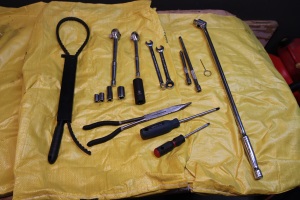
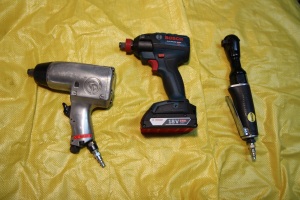
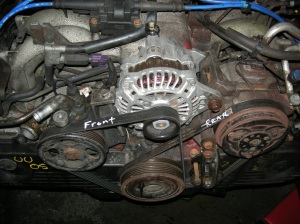
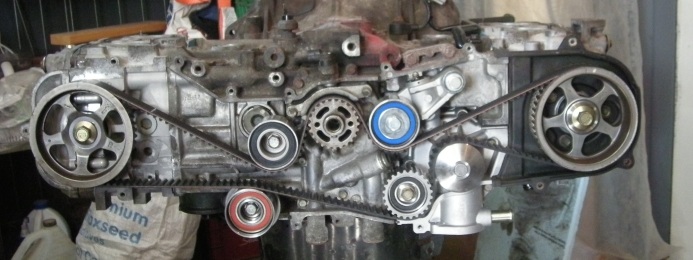
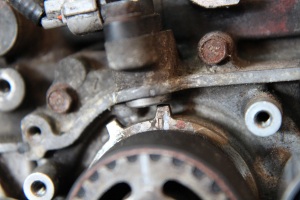
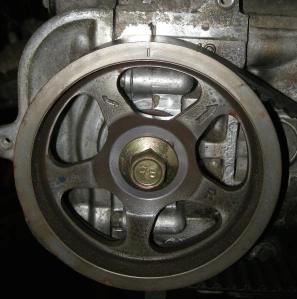
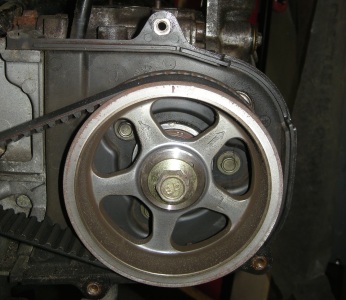
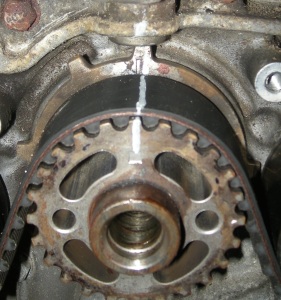

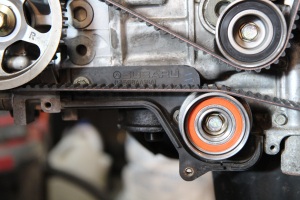
Awesome. Can you do mine?
Can you set the timing without taking the radiator everything out
Possibly, but it will be a lot easier to work with the radiator removed. Considering the effort to drain and remove the radiator. I feel like it is well worthwhile.
Sure, where are you at?
Hey shagbark221 I have trouble with the timing on an ej25 I set the marks on timing with the ones on the dealers timing belt but once I rotate then then won’t line up no matter how many times I turn the engine by hand
Yeah, those timing marks on the belt are kind of useless. I don’t know why they even put those on there. They never line up correctly. Don’t worry about the marks on the belt. Just be concerned about the marks on the pulleys and sprockets. As long as they all line up when you turn the engine over by hand. You should be all good.
Pingback: Subaru Head Gasket Replacement EJ25 SOHC | shagbarkblog
Reblogged this on Toothed Belt | Drive Parts Direct and commented:
Power might be lost and fuel might be wasted if the firing of the spark plugs does not follow proper timing. Timing is important in coordinating with the other components of the engine. A timing belt like the Toothed Belt is one mechanism that allows the proper timing and coordination of the different components of the engine. A timing belt connects the camshaft to the crankshaft. Typically, timing belts are toothed belts that relay the rotational motion of the crankshaft to the camshafts.
Most engines utilize the timing belt because it allows simpler and bigger engine designs. Unlike gear timing mechanisms, timing belt directly connects the crankshaft to the camshaft. Gear timing system may require several gears to connect the camshaft and the crankshaft. This results in a more complex engine design that requires meticulous and expensive maintenance. If one gear becomes misaligned or defective, the entire gear system must be checked and repaired.
On the other hand, engines utilizing Toothed Belts are less prone to malfunction because there are fewer moving parts that need to be maintained. A timing belt like the Toothed Belt regulates the opening and closing of the valves. Since the valves are operated by the camshaft, their timing must be coordinated with the motion of the pistons, which are connected directly to the crankshaft. Although engine mechanical output is produced by the pistons, the crankshaft is the one that translates the linear motion of the pistons into rotational motion.
My cam wheel driver side wobbles
I’m not sure exactly what you mean by wobbles. If there is a bit of play in the sprocket (when you turn it) before it turns valves, that is normal. But if you can wiggle it side to side (play in the cam shaft). It’s possible you need to replace the cam seals. You would also probably have an oil leak at the cam seals if that is the case.
What should one do if one of the cam pulleys is aligned with the crank pulley but the other has moved about 180 degrees. Does it matter if I turn it counterclockwise or clockwise or do I just need to align the marks again. I guess what I’m asking is couldn’t I possibly be off two strokes if I rotate it the wrong way to align all of the marks again. Any help would be appreciated. I don’t usually work on subarus.
Don’t be afraid to move the cams around. Make sure that all of the lines are the same as when you disassembled it. I believe that all of the cam/crank marks should be upright at one point. That is the best point to match the cam/crank marks.
I have passenger side cam & crank lined up on timing marks & when I attempt to turn driver side cam it’s extremely hard to turn, I’m concerned I might break something, why would there be so much resistance ? 2002 subaru 4 cyl, originally just replacing water pump, turned into a nightmare…. any input appreciated.
If you are turning the cam sprocket on its own, it will be really hard to turn through one section. However, there is no issue of breaking anything as long as you have the pistons in mid stroke. I believe the timing mark scratched into the block (at the factory) for the crank shaft is mid-stroke. Hope that helps.
I’ll give er a whirl, thanks for quick response
The only way I can get drivers side cam to turn is if I release crank and therefore the crank turns out of position. So when I lock crank in position and try turning drivers side cam into position, I can get it to turn two cycles or whatever you call it, but right when I get cam mark about 2″ from timing notch it won’t budge, I tried with torque wrench and was putting over 140 ft Ibs into it & still no go. I’m using a 2 1/2′ breaker bar so should be getting more than enough torque. Should it take that much force to turn that cam ?
Have a question I am currently rebuilding a 2006 Subaru Forester with the 2.5 non turbo single overhead cam it’s the ej25 engine I have aligned my crankshaft so that the Pistons are dead center after I did this and put the heads back on aligned the passenger side Cam and then the driver side can marks. At this time I attempted to turn the crankshaft all the way around without the timing belt on it to spin the cams at the same time and what I find is that when the cam timing marks are set the passenger side cam valves are closed but the driver’s side Can-Am valves are open and so when you attempt to spend the crankshaft you only get about a half of a spin before the Piston comes into contact with the valve on the driver’s side my question is is it supposed to do that or when you put the timing belt on and spin the crank does it also turn the Kings simultaneously in a way that allows it to spin freely
You’re not supposed to turn the crank when cam timing is set, because some of the valves will be open and you’ll hit them with a piston when turning the crank. You should only turn the crank with correct timing on the cams when the belt is on. That way you won’t hit valves.
You probably are using the wrong notch on the crank sprocket. The half-moon key should be at 6:00.
What a moron I can be at times, I have been trying time using arrow on crank and timing marks on crank, no wonder I couldn’t get that b(*&%$ to turn… please dis regard last post.. just hope I didn’t bend anything trying to muscle that cam into position…
Thanks, and great info here
trying to time using arrow on crank and timing lines on CAMS doesn’t work, typo above
Sounds like you got it figured out in the end. Sorry it sounded like a frustrating job.
Very soon I’ll be replacing the timing belt on a 2.5 that had blown it’s old timing belt. When aligning the crank, how can I know that it’s in the appropriate stroke? On other engines it’s easy, just plug a hole with a finger and find top dead, but can’t do that on a subie. goofy boxer engines.
Yeah, boxer engines are kind of goofy. There is a mark scratched into the block to align the crank with. It may be hard to see if the engine is dirty. It should be just slightly to the side of strait up. It is actually at mid-stroke (but that is how the alignment is on that sideways engine). Once you get the crank lined up, line up the cam pulleys (marks are usually easier to see) and you should be all good.
Based on your steps shown here, I want to say it looks like a person could change the water pump out too? I’ve been researching tackling this job myself and a lot of people say to change (have changed) the water pump when you do the timing belt since you’ve got it all taken apart anyway. Can you shed a little light on me here?
I think that it depends on the state of your water pump and how long you want to drive that car. As it is more money and once you have done the timing once, it isn’t as daunting of job if you need to replace the water pump down the road.
I know plenty of people with high mileage ej25s with the original water pump still functioning great. I did change the water pump as the Gates kit I bought came with one. But the Gates water pumps are quite inferior quality to a Subaru pump and in hindsight, I would have bought a different timing belt kit, left the original one in and just redid the seal (as it was leaking a little bit).
So, if you are going to replace it, I would recommend using a new Subaru pump, or don’t bother.
Okay, I guess when I get to inspecting the parts I’ll have to just see how it looks. Some forums and blogs I’ve read on the subject just say since you’re in there you might as well do it. But, from what I’ve come to learn about this job and my own technical proficiency with this kind of thing – I’m inclined to agree with you, I could do it at a later date, provided the pump looks fine.
And I also 100% agree with using Subaru genuine parts, I used to work in an auto parts store and I remember how jack legged some reman and aftermarket parts could be.
Thanks for the quick reply, I’m excited to get to work on it. The car’s currently at 120k and as far as I know, the belt has not been replaced, I got it at 105 – likely why it was traded in.
Yeah, I read the same thing on forums. Which is why I changed it and did some other stuff that a lot of people recommended.
In the end, I still had some other issues with the car and decided to get another vehicle rather than put more money into it. I did learn a lot, but after that experience, I would recommend sticking to necessary repairs on old vehicles.
I just wanted to extend a very sincere thank you for this guide. I got the timing belt changed on my ’05 Outback this past weekend due in large part to your detailed walkthrough here. The funny thing is when I got it taken apart the belt and pulleys looked close to new. I guess the previous owner – who traded it at 105k replaced the timing belt and then sold it. Who knew.
Working on third attempt at the timing. Right cam cog lines up with mark on wheel to the engine block. Mark on new timing belt placed there. Belt taught to the crankshaft cog which is lined up for engine in midstroke. Belt pulled taught under tensioner to the left cam cog. With wrench, cog wheel is moved until the marks line up and the belt is wrapped around and clipped in place. The remaining cog and idler are installed and the crank bolt is reinstalled. I’m turning the engine. The marks on both cams keep lining up the the crank cog, but the marks on the belt have shifted, equaling to the left (drivers side). Is this a problem? I’ve rotated the engine about 4 or 5 times around and the belt marks are all off, but equally off. The marks on the cogs continue to line up.
If the marks on the cam sprockets and the crank shaft continue to line up after rotating the engine over a few times and you don’t feel anything rubbing, there shouldn’t be a problem. So, it sounds like you got the timing lined up just right. The index marks in aftermarket belts aren’t always very precise. I ran into the same thing with the Gates belt that I put on my car, but it wasn’t an issue after 15k.
Hi there Shagbark I’m working on a Subaru Outback 2000, I’m currently trying to align both timing sprockets along with the timing crank shaft in the middle to all face that little line in the middle but every time I try to do so it just skips over it when I try to crank it towards the middle. The left timing sprocket and the middle timing crankshaft are good and both in the middle but the timing sprocket on the right just keeps skipping over the line every time I readjust it can you help me out? please get back to me as soon as possible.
If the crank mark is pointing at 6 o’clock (180 degrees from where it should be) is that still mid-stroke?
I am not totally sure, but I don’t believe so.
i have everything lined up and valves where in perfect condition but when i crank over car tries to start then backfires and stops, what did i do wrong?
me too! starts, fires a few times, then dies.
It is hard for me to guess, especially since I am not a professional mechanic. Just an enthusiast and backyard mechanic. I am curious if it would be caused by the timing, as if you had any of the sprockets out of line, it would most likely smash valves rather than cause backfiring.
One thing, I would suggest checking is all of the sensors, as if one of them wasn’t reinstalled properly or damaged, that would affect the ECU and could cause stalling or backfiring.
Hi there is was doing timing belt in my 0t subar2 impraza I got everything thing line up removed the belt every thing still lined up however I turned the crank pulley and both my came changed the alignment what I should do please some help
If you removed the belt how are the cams turning when you turned the crank?
When you turned the crank around, that would move the pistons up and down. One of the pistons could have pushed a valve closed and caused the cam to move.
Don’t worry, once you get the crank back into position, you should be able to move the cam sprocket back into alignment before getting the timing belt on and all should be well.
Thank you for the replay
I will try that
Hi there is did what u told me but the passenger side cam dose it have to be tight to align or free because I can can turn it to the align mark by hand but the driver side it’s very tight when I put it to the mark
It depends where the valves are when you are turning the cam sprockets. It is normal for one of them to be hard to turn through part of the cycle. Just get the crank to the right point before moving the cams around. The mark on the block for the crank is actually mid-stroke. So, you can be sure that the valves won’t hit anything while adjusting the cam.
Once you get everything lined up and the belt attached, be sure to turn the crank around a few cycles to make sure that the cams and crank keep lining up and you don’t feel like anything is hitting. Once you get to that point, you should be good to go.
Sorry 05 subaru impreza rs 2.5
Just did timing belt, tensioner, pulleys, water pump. After completion, the motor runs fine, still has good power but not quite as smooth as before. It’s almost as if it has a slight miss in the timing. Is it possible that one of the cams could be off a notch?
I suppose it is possible. After you attached the new belt, did you turn the crank over a few times to make sure that all of the marks continued to line up? If so, there shouldn’t be an issue with how the timing is set.
thanks. I would think that if one of the cams was off a notch, that it would run really crappy. It runs pretty good, but just a slight little “something” that wasn’t there before. My air filter came loose (this engine is installed in a Vanagon) around the same time and I’m wondering if maybe the engine compensated and is running rich. Going to try and reset the ECU and see if that changed anything.
Yes, I agree that it would probably be running really bad if the timing belt was off a little, or possibly even smashing valves. I don’t have enough experience to know exactly. But from your description of your issue, it does sound like an issue with the tune. This could be from a faulty sensor, or a sensor that isn’t getting a proper reading. On most vehicles, when the ECU can’t get a proper reading, it goes into safety mode and tends to run rich.
Resetting the ECU is a good idea. I would also recommend checking to make sure that all of your sensors were installed and located properly when you did your swap into the VW. Good luck.
If there was no problem before the timing service and there is a problem after the timing service then most likely the problem has something to do with the work performed during the timing service.
You could take off the timing cover and line up the crank to 12 o’clock and make sure the cams are still correctly lined up.
hi ive changed the belt but now the car wont run . the cogged idler failed on last belt so i need to reset the timing completely .my question is should the crank be slightly past 12 and the marks a=on the cam should i use the stamped marks of the paint marks ?
Just Google for “subaru timing” or similar and look at the images which will show you what needs to point where.
BTW my wife’s sprocketed idler also died and we were lucky there were no bent valves.
sorry typo i mean the marks on the cams should i use the stamped lines on the edge of the wheel or the paint marks on the wheel between the stamp line??
The cam sprockets and crank should all be lined up with the stamped marks on the block to the stamped marks on the pulleys. If there are painted lines, they aren’t from the factory and could mean anything. Trying to find another picture or video describing where to find the marks is a good idea.
ok so i went out and removed the belt for the 100th time and set the cam wheels using the stamped mark. and also set the crank using the square stamped into the pulley and the timing mark on the block ..it wont run and when it does its rough and wont idle do you think is have the crank a bit to far advanced on the timing mark??
I’m wondering if there is some other issue. As it sounds like you have the timing marks lined up. I recommend before starting it, that you manually crank over the engine with ratchet with the timing cover removed and watch to make sure that the marks continue to line up and you don’t feel any resistance before trying to start the car. If you did that first, your timing should be set up okay and the issue with it running rough could be something else.
i have done that before i get in it to crank it over ..i do feel a bit of a hard spot as i turn by hand i thought that may just be compression. however do you still think the timing on the crank maybe off slightly or can it be off a little bit its not exactly at 12 oclock
By your description, it sounds like you have it set up properly, the teeth are pretty big on the cam sprockets and if you had one off by a tooth, it would be very obviously out of line. Also, the engine should be difficult to crank over through part of the full revolution. If it was out of line, it would feel more like one of the pistons was hitting something. It sounds like the belt and timing is set up fine.
If your car has issues starting and then runs rough, issues with ignition are usually related to either fuel, air or spark. First I would make sure that everything that you disconnected or removed was re-attached properly. Then, there is plenty of info out there to try and diagnose why your car won’t start/run properly.
i had it running great at one point but when i had to remove the harmonic balancer bolt it was super tight and i moved the crank and now i have this current issue..thanks for all the help back at it in the morning ..
Hold on… The cogged idler failed? Was the motor running when the pulley failed? If it was running you may have bent some valves. Do a compression test on all cylinders. Pull the fuse for the fuel pump/ignition. remove a spark plug and screw in the tester. Crank the motor a few times till the needle on the gauge stops moving. If all 4 readings from all 4 cylinders aren’t close you have some bent valves.
I just purchased a 99 subaru forester that overheats after a few minutes of driving, the owner said it was a blown head gasket. I did one on a dohc subaru so I figured no problem. I pulled the motor out of forester and removed timing cover and to my surprise the cam marks were both 180 out! The marks on the pulleys are both straight down? The guy said he had gasket work done in the past and a refurbished head installed on the right cylinder. The engine ran fine. I’m confused. When I put the motor back together with new head gaskets should i line the marks up according to manual?
what if the cams have been removed from the head
i got my heads back from the machine shop and he said he had to remove the cams now my mark is almost 180 n if i line them up the valves r open so i need help with that too.
Not sure exactly what your problem is. The index marks where you line up the cams to the pistons is actually mid stroke not TDC. As there isn’t really such thing on a boxer engine. So, some of the valves would be open when you line up the cams. And always test the line up of the timing belt after you attach it by rotating the engine over a few times by hand with a ratchet before bolting the timing cover back on. Hope that might help.
Hey, I have a 2000 outback with EJ25 that needed head gaskets. I had the heads machined and valve seals replaced. I put the head back in place and before I got any further along, I alignment checked the cam sprockets. The right (pass.) is fine but the left is short about thirty degrees from the 12 o’clock position.
I removed the head thinking I’d done something wrong-there’s only one way that cam, rocker arm assy goes together soooo, I need some help please. Left cam sprocket won’t line up on marks due to spring tension.
Help please.
Are you still answering questions in this thread? what if the new belt seems to small, or tight. Is there a trick to get it on? should it go back on easily? or is there a reason it’s being a pain
It will be tight. Make sure you don’t pull the pin for the tensioner till you have all pulleys bolted in and confirm the belt still lines up after a few full rotations of the crank. The last pulley is a royal PITA to bolt in due to the tightness of the belt.
tight is an understatement! I’ve tried all day to get this dang timing belt on my 11 impreza with no luck. nearly messed up the bolt treads on the lower cog when trying to some what tilt it to get the belt on. I’m at a loss!
Has anybody found any info on the belt tightness? I’m using a gates belt that was included in an AC Delco kit. Getting the lower cog bolt on is unreasonably difficult. Then, the tensioner pin can be pulled out and put back in. I ended up putting it on and taking it off to inspect things. Now I can’t get it back on.
Hi, I read every post but there is still one question I have. I am timing an EJ 18, both the cams and crank are lined up but the distributor is of by about an inch. In other words I have to remove the adjuster bolt and push the distributor down under the bolt for the engine to run. Don’t know why? Can you help with some advice?
I was looking for Timing Belt Warning signs. But your reading is also worthy
Warning Signs of Timing belt
Hi, I’m hoping you are still checking this blog and helping with suggestions.. I have a 2011 subaru impeza. I replaced the water pump and all new pulleys timing belt ect. My problem is getting the timing belt on. for the life of me try as I may I can’t get the belt on to the pulleys/spocket. I haven’t pulled the tension-er pin yet either. am I missing something. should this belt be this tight? Thanks!!
No, it shouldn’t be that tight if you haven’t pulled the pin on the tensioner sprocket yet. I would double check that you have the right belt and sprocket kit for your year of car. Also, to double check that the belt is wound in the right directions around the pulleys/sprockets. Good luck.
anyone know the tooth count for a 2006 ej25 sohc (forester)? my timing looks spot on, with 47 to the passenger side and 44 to the driver side. I’ve heard lots of comments that a tooth off just sounds a little rough. i replaced a leaking head gasket when it ran fine with 200k and it just sputters and dies now. if i give it lots of gas, it runs. anyone else find the solution to a similar issue? hoping it’s a sensor because the timing looks spot on. now to find the sensor…
or do the L and R cam pullleys matter what side they are on? this may be the issue. I have an L and R on mine but i dont know if it is facing the engine or from inside the car.
What steps should I do on an ej25 dohc on setting timing? Long story short. Removed belt to replace. Had to go on work out of state. Returned and driver side cam doesn’t match and hard to turn to match lines up
Scott,
Good evening
the cogged pulley (or sprocket) beside the water pump on my 1999 Subaru Legacy GT blew up and all the ball bearings came out it
I bought a new one
now can I just replace that and it should be fine?
the timing belt is still on and
my mechanic had said it looked like a new timing belt and water pump for the past two years when he did inspection on the car but that pulley looked old
THANK YOU!!!!. I followed your directions for timing after fitting a new belt, and they worked perfectly! I just can’t understand how I could have gotten it so wrong. Your easy to understand instructions are pure gold! Thanks so much
What happens when when the timing belt snapped?